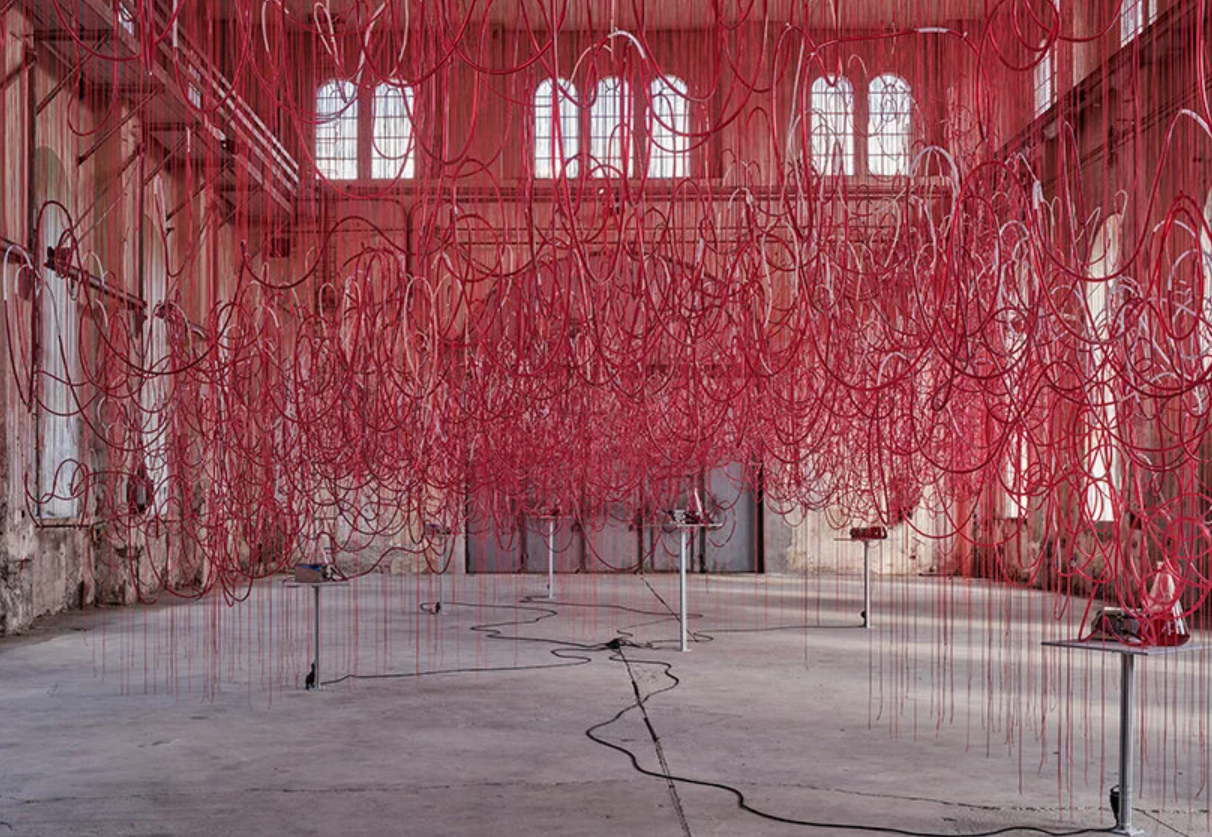Design Boom : ‘WHO AM I TOMORROW?’ BY CHIHARU SHIOTA
red liquid flows through chiharu shiota's ‘who am I tomorrow?' tube installation
Chiharu Shiota, known for her installations using threads, merges abstract concepts with everyday objects. In her latest project titled ‘Who am I Tomorrow?,’ the former assembly hall in Kunstraum Dornbirn, Austria, is transformed into a mesh of red threads resembling a labyrinth. The installation gives the impression of a living organism, suspended above visitors and harmonizing with the historic architecture, connected by a complex network of red lines.
Stepping inside, visitors are surrounded by this floating structure. On closer inspection, intertwined tubes become apparent. Held up by over 5,000 red threads, the installation seems to move subtly, as if red liquid, symbolizing blood, flows through winding paths that stretch for around two and a half thousand meters. Some tubes break away from the main structure, descending and connecting to Erlenmeyer flasks through medical pumps.‘We all live, work, sleep, love and suffer physically driven by a constantly functioning cardiovascular system. With a heartbeat of about 70 beats per minute, approximately 10,000 liters of blood are pumped into around 100,000 kilometers of blood vessels every day,’ describes the artist.
Chiharu Shiota: ‘Who am I Tomorrow?’, Kunstraum Dornbirn 2023, all photos by Günter Richard Wett (unless stated otherwise), © the artist / Bildrecht Vienna 2023
CHIHARU SHIOTA’S BLOOD-INSPIRED FLOATING INSTALLATION
Chiharu Shiota (see more here) takes the concept of blood circulation, makes it larger, and places it within the hall’s structure in a specific way. Instead of the heart, pumps move what looks like blood through the veins. Sometimes, this ‘blood’ is temporarily removed from the cycle and stored in a container before being put back into the cycle using a pump. This process is similar to how the heart-lung machine works during open-heart surgery.
In the exhibition, the absence of the body is a way to highlight the importance of mental consciousness. Without the body, the cycle can’t exist. Everything is connected, so if one part doesn’t work well, it affects the rest. This idea of the inside being connected to the outside is seen throughout Shiota’s work. Just like how our bodies are surrounded by skin and clothes, contained by our surroundings, and situated in the world, the bigger picture includes our place on Earth with other living beings. Blood here represents one’s personal information about origin, nation, family, health, and illness. Normally, we can’t see blood inside us, which is fascinating and sometimes scary. We only see it when we’re hurt or in extreme situations.
the installation is hanging from an 11-meter ceiling with over 5,000 red threads
INTERCONNECTEDNESS THROUGH ART
The artist’s comparison of her work to the bloodstream isn’t only about humans; it applies to all living things. This idea highlights how people are connected to their surroundings, a central theme in Shiota’s art. For Shiota, her art is like a home and a way to talk to the world. She uses her own experiences to create it, drawing from her life and what she’s been through. She works with the meanings that come with being a Japanese woman, a daughter, a mother, a healthy person after cancer, someone who’s suffered a miscarriage, a sister, and an artist in the global art scene. Her big installations, drawings, videos, performances, and objects become a way for others to connect with her work, making personal stories feel like shared ones.
some tubes detach from the assembly and lead downwards via a medical pump into an Erlenmeyer flask
The title is focused on the question of identity, all the things that make us who we are. This includes our life experiences, how we act, our habits, our social and cultural surroundings, things we’re aware of and things that affect us without us realizing, the spirit of the times, and even how different generations shape us. When we read the question, we naturally think about what might happen tomorrow, considering what’s going on now. It’s like wondering if we’ll become someone different, leaving behind who we are today.
‘How much influence do we have on that? How much power does our environment have? And how much responsibility do we have for this environment in a constantly reciprocal relationship? “Tomorrow” is a concrete temporal specification, relatively little time passes until then. So how big can our own transformation be? What does tomorrow’s version of me look like? And what will it change?’ Shiota raises these and other questions in a way that’s easy to understand. The installation helps us feel more connected to the world around us.
normally, we can’t see our blood, which is interesting and sometimes scary
red liquid flows in many twists along paths that are almost two and a half kilometers long
Chiharu Shiota, Berlin, 2020, Photo Sunhi Mang, © the artist / Bildrecht Vienna 2023



Article published on : https://www.designboom.com







